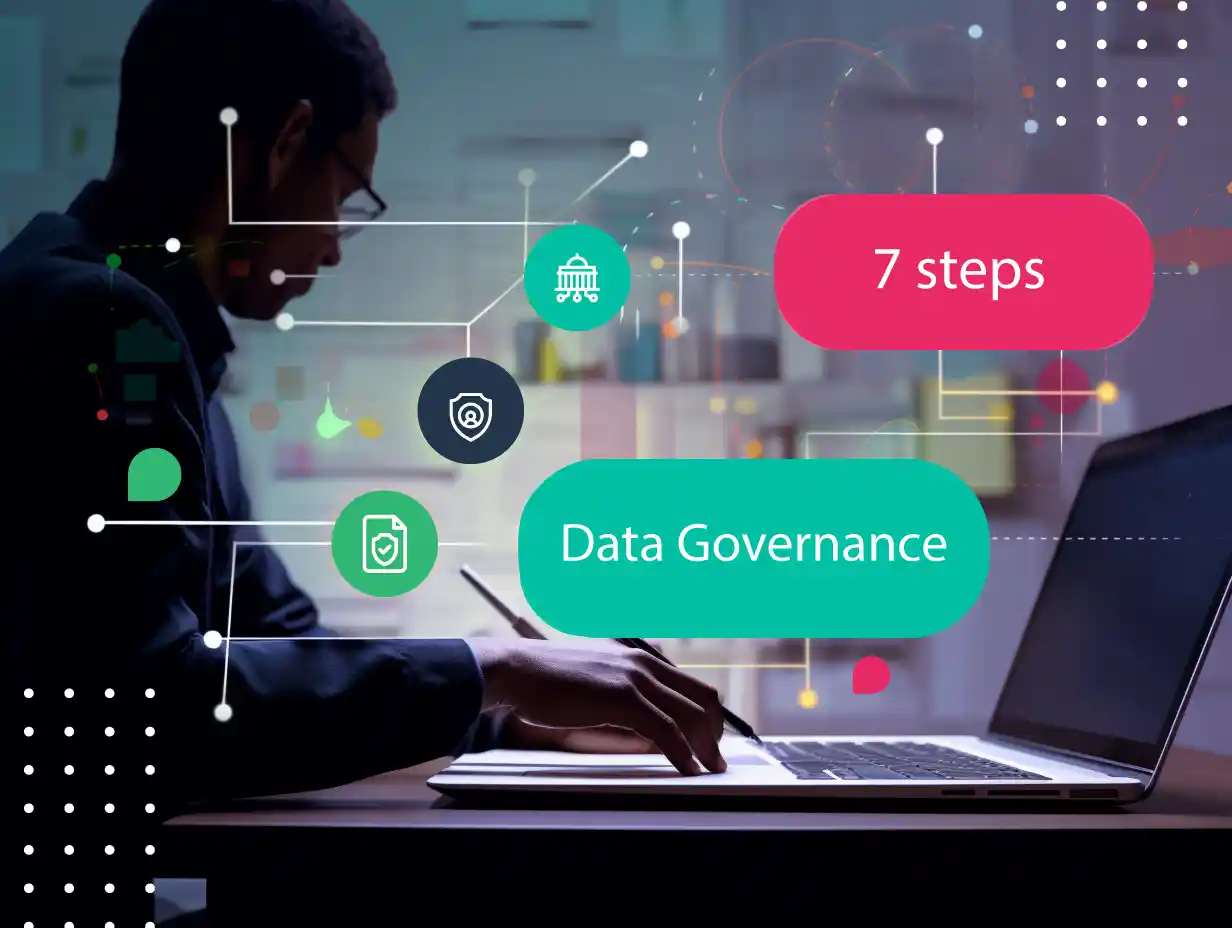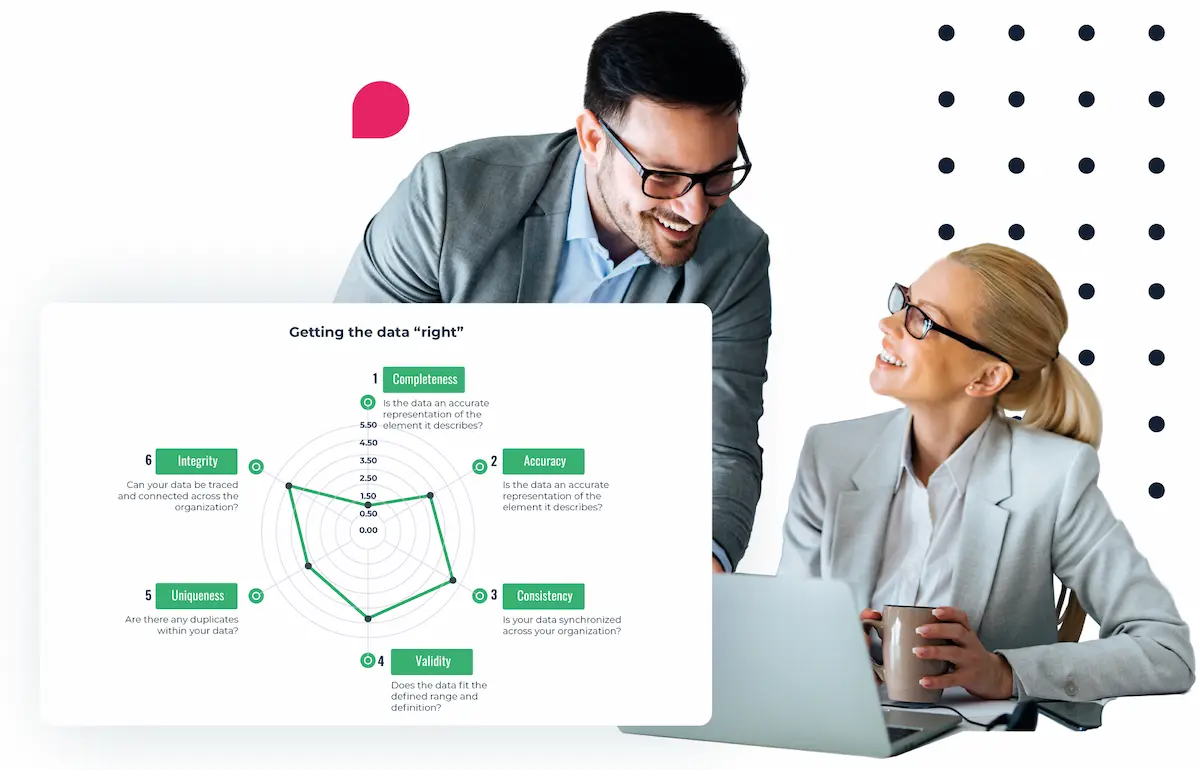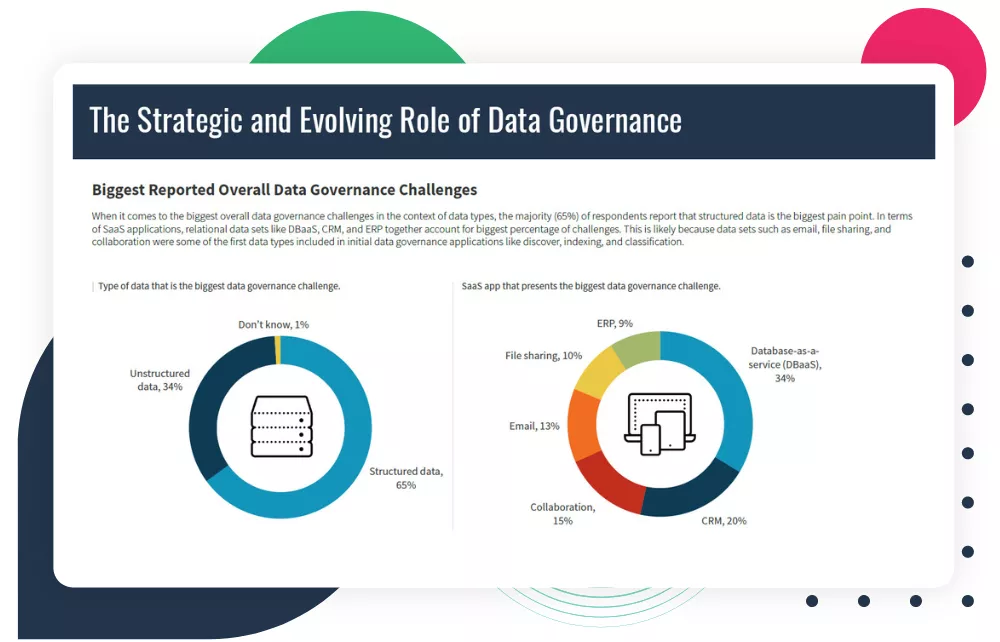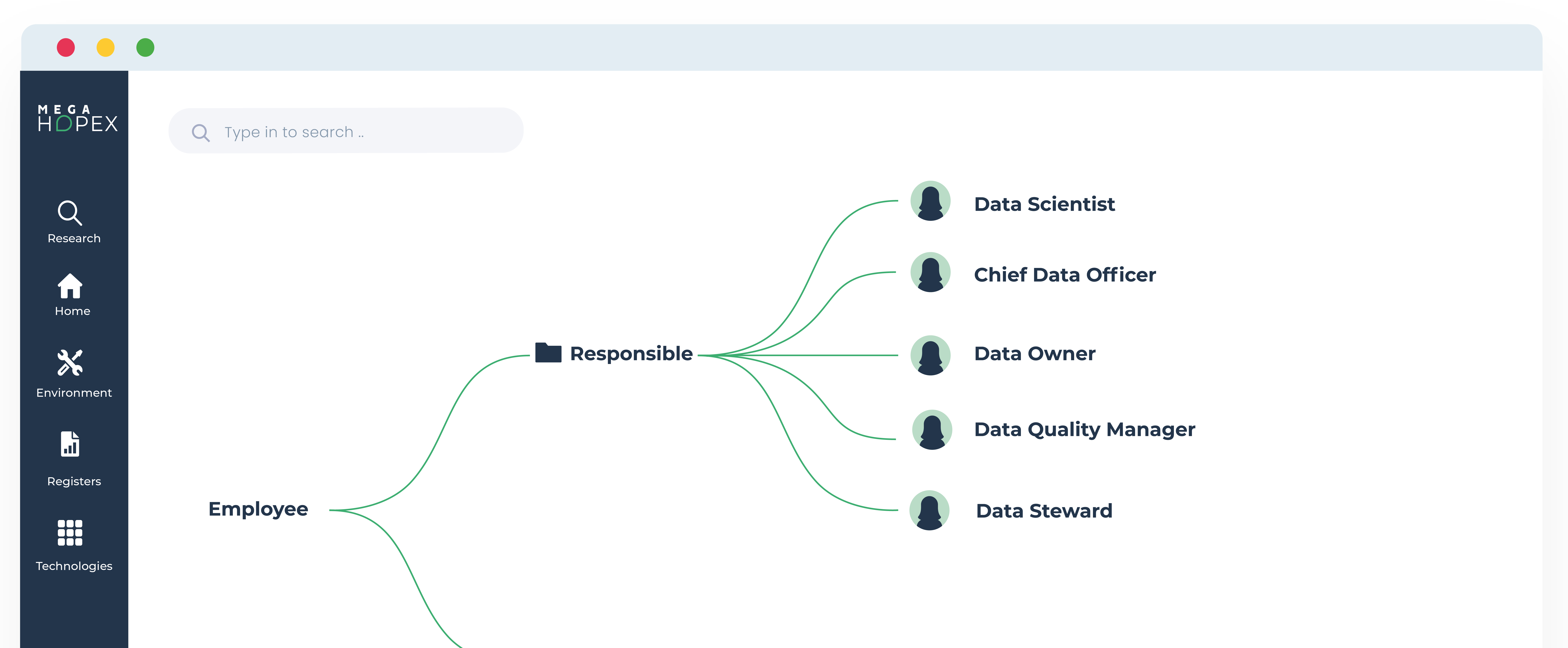
7 Key Steps to Successful Data Governance
Data governance is essential for any organization that wants to remain competitive in today's digital world. A successful data governance strategy can help organizations unlock the actual value of their data, enabling them to improve decision-making and create a secure environment for handling sensitive information. Having the right processes in place for managing and protecting data assets can be a huge advantage, not just from an operational perspective but also from a strategic one.
Despite growing awareness and numerous initiatives in recent years, data is considered a source of innovation and added value, which still needs to be improved to value in companies.
Sharing data in organizations cannot be decreed but suggested and encouraged so businesses play along. The reasons to share data are simple: regulatory compliance is mandatory for all players, but it is, above all, data enables innovation for performance gains and growth potential. However, the process remains complex, with significant challenges to overcome regarding data governance.
What is critical for successful data governance?
A successful data governance strategy starts with understanding the organization's business use cases and linked data needs. Once this first strategic step is achieved, stewards can start identifying the organization's data, its location, who owns it, and how it is used. Data governance should also include developing compliance policies and procedures that ensure access to data is secure, reliable, and up-to-date.
Regularly assessing the effectiveness of existing controls and making improvements where necessary is also essential to ensure that data remains managed.
Creating a culture of data stewardship and ownership is critical so everyone understands their role in leveraging an organization's data. By following these steps, organizations can build a robust data governance strategy to help them use their information assets better and improve their business operations and overall performance.
Best Practices for Successful Data Governance
In today's data-driven world, businesses face numerous challenges in managing their data effectively. With the proliferation of data sources and the increasing regulatory requirements around data privacy and security, companies need help to ensure their data's accuracy, completeness, and consistency. This is where data governance comes in - a set of processes and policies that enable organizations to manage their data effectively, ensuring that it is accurate, accessible, and secure.
Successful data governance is about setting up a framework for consistently, controlling, and competently managing data assets. It involves defining roles and responsibilities, setting up policies and procedures, and establishing standards and guidelines for data management. With a strong data governance framework, organizations can ensure that data is reliable, trustworthy, and high quality.
Here are some essential steps to achieving data governance success:
1. Get Business Lines on board with data ownership
In an organization, there are many types of data, and they are constantly increasing with digital technology. Each data is owned by a business function.
Historically, some data has been shared between processes (customer data between marketing and sales, product data between research and production, financial data between sales and finance, etc.).
Still, today it is the complete cross-functionality of the organization that can create value through innovation.
However, can this transversality be decreed? Yes, partly, with regulations (and the associated fines) that impose global data management as part of a compliance obligation. This is the case, for example, with the GDPR, for which the company must prove its control and good management of all personal data processed within the organization to avoid big fines (4% of gross GDP).
But to be a natural source of innovation, this transversality must be acquired: the business units must understand how sharing their data with other organizational stakeholders can benefit and motivate them. The use of artificial intelligence (AI) provides a good example. By pooling all data for global governance, all business units can benefit from the disruptive innovations offered by AI: detection of weak signals, fine-tuned understanding of customer behavior, etc., based on stable, reliable, and controlled data.
If the proximity of the data science team to the business can be additional motivation, an evangelization and onboarding phase is essential. This is one of the roles of the CDO (Chief Data Officer), who organizes knowledge, promotes exchanges, and ensures data reliability and compliance. They also involve each data "owner" in the process.
In short, to build this shared data culture, the CDO must find business sponsors - including at the board level - and set up a charter for the Data Governance approach, then organize the information, communication, and induction process for the various data owners.
2. Build the missing link between business and technical data
Data governance aims to know and catalog all an organization's data, evaluate and improve its quality and conformity, and provide it to the stakeholders who ensure the smooth running of the company. This is a highly technical concept - data being an IT asset - but the priority is responding to business needs and challenges.
The business units and data scientists will select the most relevant business concepts and dimensions based on a defined use case (detecting future customer behavior with A.I.,…). This "data shopping" is done first via the business glossary (concepts and related elements) and then via the data catalog, which is the concrete image of the data in the existing systems (applications) - and, therefore, the data sources to be reused according to the quality, validity, freshness of the data, etc. This essential technical part becomes more easily accessible to all actors via the business glossary.
3. Modeling the data life cycle
Data is not static; it has a lifespan. Therefore, simple mapping is not enough: data governance requires modeling the entire data life cycle: creation, use, reuse, obsolescence, and destruction (GDPR). Objective: to link business process modeling and data governance, to save time and understand business issues.
In this context, to accelerate data governance, it will be necessary to rely on the business processes already known in the company (data entry and use in the various departments), the systems using this data, and the company's risk management procedures (personal data controls for example).
Thus, the business process documents each of the activities of the business stakeholders that will be used data in the organization. For example, when setting up a credit offer in a bank, the financial advisor enters data (ID card, salary, family situation, medical situation, etc.) used for the entire process.
4. Promoting quality to enhance the value of data
Controlling data also means maintaining its quality (because only good-quality data at the beginning of the collection process guarantees the quality of the use case at the end). For example, a credit agreement or an insurance cost depends on the data collected and used initially on a given customer. This is the only way to ensure the performance of the service provided to the customer and innovation within the framework of an industrialized (production), reproducible, and agile process.
Data quality is already measured in many client IT systems in a heterogeneous and compartmentalized way. Implementing advanced data governance implies enabling a central repository for control and quality rules. This will avoid duplicating controls, concentrate all available measures, complement them, and set up improvement plans for priority data.
5. Facilitating the integration of regulations and standards
Regulations and Standards and are generally perceived as constraints that generate costs. However, they can also lead stakeholders to collaborate and thus represent opportunities for value creation.
However, new regulatory obligations are constantly emerging while generally complementing previous ones. Effective data governance with each new development consists of not starting from scratch but capitalizing on the controls already in place to identify the elements necessary and complementary to be integrated for an efficient implementation.
6. Making data governance a long-term process
New markets, new offers, new automated processes... the collection and processing of data is constantly changing. If the implementation of data governance is long and complex, it is never finished and must be a long-term process.
As in any project, the first use cases must demonstrate real efficiency ("quick win") to get the ball rolling. And it is the role of the CDO - through dashboards and indicators - to know how to communicate the results to his community to continue to build optimal data governance and to motivate and multiply the uses in the long term.
7. Establishing a culture of the data-sharing organization
In "digital native" companies, such as GAFAMs or start-ups, the data culture is native. Mainly since the added value of these new leaders is generally determined and built on data. In other companies, it is a whole mindset that needs to evolve.

Change management is long and complex. It requires a lot of persuasion from the CDOs, who must rely on successful use cases to create a data-sharing environment (data literacy) and thus foster innovation and offer new competitive advantages to the company.
Measuring the Success of data governance
Measuring the Success of data governance can be complex, as it involves assessing many different aspects. One way to approach this is to look at quantitative and qualitative metrics. Quantitative metrics include data accuracy, compliance rates, and cost savings from improved efficiency.
Qualitative metrics can provide a more holistic view of Success, such as levels of employee engagement with the data governance program and the effectiveness of communication between stakeholders. Additionally, surveys or interviews with stakeholders can provide insight into their satisfaction with the program.
Ultimately, assessing the Success of a data governance program requires looking at multiple measures and taking a comprehensive view of how well it is performing.
The role of Data Governance is, therefore, to promote the transformation of the company, its sustainability, and its renewal to face disruptions and market changes. In other words, the biggest challenge for CDOs is to raise awareness so that all stakeholders move together toward innovation and value creation to ensure the survival and development of the company.
Data governance tools are equally important
Data governance tools provide a framework to manage data assets and ensure data is accurate, consistent, and accessible. These tools make data management more cohesive with siloed data and inconsistencies.
The role of data governance tools is to provide a consistent and repeatable process for managing data. They help organizations track data lineage, ensure compliance with data privacy regulations, and establish data quality metrics.
They allow data governance teams to standardize data policies and procedures across the enterprise, ensuring that data is used for maximum insights while remaining compliant with regulatory standards. With the ever-growing volume and complexity of data, data governance tools are essential to ensure that data is managed effectively and efficiently, enabling enterprises to make data-driven decisions confidently.
Summary
We emphasize the importance of having a clear data governance structure that defines roles, responsibilities, policies, and procedures for managing data effectively. Regular data audits and assessments are crucial to maintaining data quality, accuracy, and security.
Collaboration and communication among stakeholders are critical to building trust and alignment around data governance initiatives. Establishing a data governance council or committee that includes stakeholders from various departments and business units to provide oversight and governance on data-related initiatives is also recommended.
Providing adequate training and support to users and stakeholders is equally important to ensure they understand and adhere to data governance policies and procedures. Finally, leveraging technology solutions like data management platforms, automation, and analytics tools can significantly help simplify and streamline data governance activities. A well-structured data governance framework should be flexible, scalable, and agile to meet changing business needs and support data-driven decision-making.
FAQs
Measuring data governance success can be determined by compliance with regulatory requirements, data accuracy, completeness, and effectiveness of data management processes in delivering business use cases. Additionally, monitoring user adoption and satisfaction with data governance policies and procedures can provide insights into Success. Key performance indicators (KPIs) such as data quality, policy compliance, and data reuse can also be used to measure the progress and success of data governance initiatives.
The three key elements of good data governance are privacy, accuracy, and accessibility. Privacy ensures that data is secure and protected from unauthorized access. Accuracy ensures that data is reliable and consistent in quality and completeness. Accessibility ensures that stakeholders can easily access the data they need when they need it. Implementing these three elements is crucial for efficient and effective data management.
Successful data governance involves various critical factors. It is vital to have a strong data governance framework along with clear policies and procedures. A dedicated team responsible for managing data compliance is necessary.
Having a data management process with defined roles and responsibilities is also vital. Monitoring and auditing data usage and access are essential to successful data governance. Finally, communication and education about data governance policies and procedures should be ongoing for all employees.
The most crucial component of a successful data governance program is effective communication. Clear and transparent communication between stakeholders can help ensure that everyone understands the importance of data governance and complies with the policies and procedures. It also allows for swift identification and resolution of issues or inconsistencies. With strong communication, even the best-designed data governance program can succeed.
Related Content to Data Governance
Turn your data into a strategic asset
MEGA HOPEX for Data Governance
Request a demonstration of HOPEX for Data Governance, and see how you can have immediate value for your projects.






